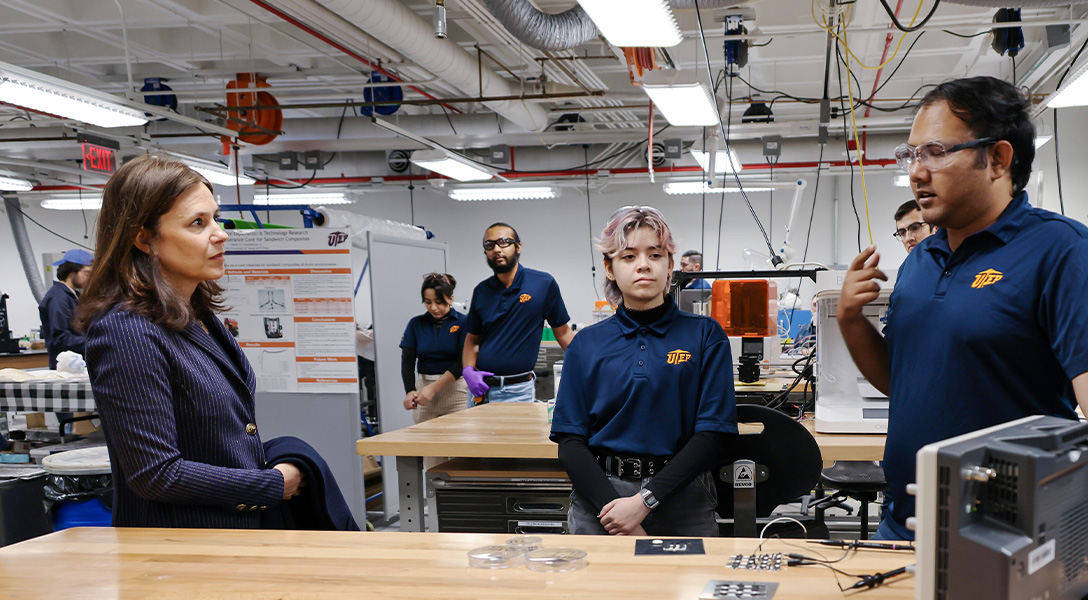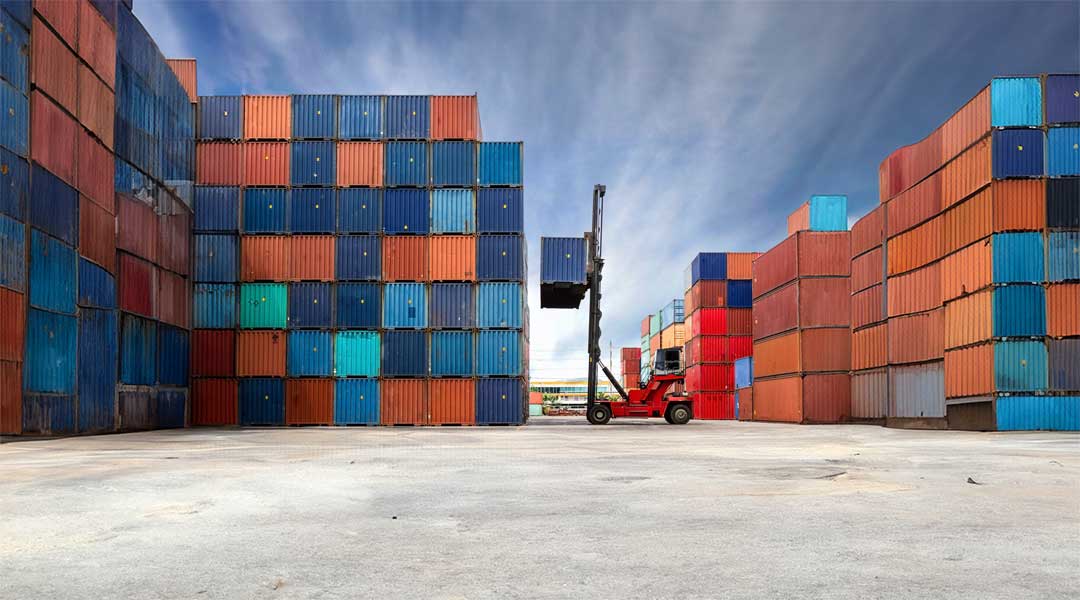
El Paso aims to end brain drain with global manufacturing, higher-paying jobs
| 360° in 365 El Paso takeaways |
|
|
Dallas Fed President Lorie K. Logan met with El Paso business and community leaders in mid-October to learn about the area’s strengths, challenges and outlook. El Paso was the second stop in the 360° in 365 Listening Tour , as President Logan travels through the Eleventh District reaching out to local constituencies so she can represent the district in the national policy discussion and be a force for good at home. Over the course of the coming year, this listening and learning will position her and the Dallas Fed to identify policy priorities that will make the greatest impact for the region over the long term. We describe the El Paso region and share what was discussed. |
Situated on the U.S.–Mexico border across from Ciudad Juárez, El Paso is an international trade hub as well as part of the fifth-largest manufacturing center in the Western Hemisphere and one of North America’s largest binational communities.

Cross-border commerce is important, with 49,000 daily visitors from Mexico boosting El Paso’s retail and food services sectors and accessing its health care services. The federal government’s presence is also outsized. The metropolitan area is home to Fort Bliss, the Army’s second-largest base, as well as to a significant contingent of Customs and Border Protection personnel and other federal agencies.
El Paso’s population is predominantly Hispanic, and while the regional economy is expanding, education and income levels are relatively low. Digital infrastructure is lacking, and internet access is limited relative to other large metros. Strong, thriving institutions such as the University of Texas at El Paso (UTEP) and El Paso Community College are education anchors. However, the area has experienced net outmigration, particularly of young, skilled workers.
Community and business leaders highlighted three long-term priorities during Dallas Fed President Lorie Logan’s visit. The first is increasing the depth and breadth of the local labor pool by increasing educational attainment and slowing the brain drain of skilled labor. The second is attracting advanced manufacturing companies to the region through growth of the aerospace and defense manufacturing sector, a focus of research and development at UTEP.
The third priority is improving the standard of living of low-income households, in part by establishing affordable and accessible broadband internet access.
Educate, attract and retain high-skill labor
El Paso’s educational attainment lags behind the state and nation. About 81 percent of El Paso adults 25 years and older have a high school diploma, compared with more than 85 percent in Texas and more than 89 percent in the U.S., according to the 2021 American Community Survey.
Local business leaders cite limited educational attainment as a contributor to their difficulties finding and hiring qualified labor. Such complaints are widespread, with many businesses struggling to fill positions for IT workers, accountants and nurses.
During Logan’s visit with UTEP leadership, she learned how the university seeks to address local workforce demands. One pillar of this mission is improving access to higher education by raising acceptance rates and meeting students where they are. Another pillar is boosting interest among prospective students in UTEP’s more-popular programs, such as computer science and nursing.
UTEP has an enrollment of 24,000 and, notably, the student body and faculty reflect the demographic fabric of the community—95 percent racial and ethnic minority students, 50 percent first-generation college students and the highest percentage of Hispanic faculty among top-tier research (R1) universities.
UTEP and local leaders are also working to promote advanced manufacturing in the region. UTEP’s W.M. Keck Center for 3D Innovation and the school’s Aerospace Center are in the early stages of developing an ecosystem in additive manufacturing (a computer-controlled process that creates three-dimensional objects by depositing materials in layers, similar to 3D printing) and are doing research in aerospace, defense and energy. The U.S. Economic Development Administration’s Build to Scale program awarded the centers a $1.5 million grant in 2021.
Local leaders told Logan they believe additive manufacturing will build on the region’s strengths and is an opportunity to bring back manufacturing along with quality jobs and higher wages. Local additive manufacturing capabilities would also help mitigate future supply-chain disruptions, they said.
Reshoring Asian production to Ciudad Juárez holds promise
Much of the production of Ciudad Juárez’s maquiladoras—foreign-owned, Mexico-domiciled manufacturing plants—flows to the U.S. through the El Paso Trade District, the 12th largest of 46 trade districts in the nation (Chart 1).

Proximity to Ciudad Juárez and cross-border linkages drive growth in El Paso’s service sector industries that are complementary to manufacturing production and to international trade, including transportation and logistics, warehousing, accounting, finance and commercial real estate.
The neighboring cities often share economic ups and downs. For example, when China entered the World Trade Organization in 2001, some manufacturing plants and business investment left the region for Asia, with negative repercussions felt on both sides of the border.
More recently, there have been signs that the offshoring-to-China trend could be reversing. Local leaders told Logan that companies with operations in China, Malaysia and Taiwan are relocating to or opening new plants in Ciudad Juárez to mitigate supply-chain risks and avoid U.S. tariffs on Chinese goods. They said positive spillovers are expected for the El Paso economy as the demand for logistics and other business services grows. However, a significantly increased flow of goods, services and people across the border could strain existing infrastructure.Closing the digital divide
Logan also visited with members of Borderplex Connect, a regional coalition of stakeholders examining the availability of broadband internet and ways to improve access. The group is working with the Dallas Fed’s Advancing Digital Inclusion initiative, which assists communities by convening stakeholders and providing training and technical assistance to assess community needs and infrastructure gaps.
Borderplex Connect leaders shared their analysis that found 43 percent of El Paso County residents and 27 percent of businesses lack access to a broadband connection.
Residents of Lower Valley in the eastern portion of the city, one of the poorest ZIP codes in the nation, have experienced the digital divide on a scale that limits the local economy’s ability to grow. Without broadband internet access, simple tasks become obstacles because students cannot do their homework and people can’t apply for jobs or access online banking.
The coalition’s next steps are to work with community leaders and residents to create a strategic regional plan to address broadband infrastructure and affordability as well as IT skills. El Paso County and the city have earmarked funds for digital equity projects.Managing international migration into the region
Adding to El Paso’s challenges is the need to deal with international migration, much of it humanitarian migration from Central and South America and the Caribbean. Border Patrol encounters with migrants reached record highs in 2021 and 2022, a reflection of the unprecedented volume of border crossings.
Migrants who have been processed and released into the U.S. can receive assistance from a network of U.S. nonprofits. The El Paso Migrant Welcome Center serves as a connection from their arrival at the border to their chosen destination, often New York or Chicago.
During Logan’s tour of the center, leaders shared that they came under particular strain when the usual 200–300 migrants per day swelled to nearly 1,000 over the course of three weeks in September. They noted that almost all the migrants who came to the center were from Venezuela—many without sponsors and most applying for asylum.
Since a federal rule change on Oct. 12, Venezuelans have largely been turned back by border authorities, leading to a sharp decrease in crossings into El Paso.
Overcoming challenges with resiliency and a vision
El Paso has shown remarkable resilience and adaptability over the decades. El Paso is exposed to economic change in both the U.S. and Mexico as well as in trade and immigration policy and, most recently, pandemic policies that shut down the international border to all but essential activity and personnel. After every shock, the region has adjusted, found its footing and gone on to thrive.
El Paso officials have a vision that harnesses their region’s strengths for the future. The right moves today—whether it’s investing in higher education, combating the digital divide or working together to attract new business investment—should enhance economic growth, heighten educational attainment and slow the region’s brain drain.
About the authors
Eleventh District 360° in 365 Tour: The El Paso Visit
Oct. 18
- Reception and dinner with Dallas Fed and El Paso Branch board and advisory council members at the El Paso Branch.
Oct. 19
- Meeting with leaders of the University of Texas at El Paso. Tour of the W.M. Keck Center for 3D Innovation and the UTEP Aerospace Center.
- Meeting with members of Borderplex Connect to explore the extent of the digital divide in El Paso County.
- Luncheon and roundtable discussion with business and community leaders from CBRE; the Greater El Paso Credit Union; College of Business Administration, University of Texas at El Paso; The Hospitals of Providence; United Way of El Paso; Tecma Group; El Paso Chamber; Western Heritage Bank; Borderplex Alliance and Sundt Construction.
- Briefing and tour of Fort Bliss, including meeting with base command to discuss the economic impact of the installation.
- Visit El Paso Fusion and Migrant Welcome Center to observe and learn about efforts to assist border crossers arriving in the U.S.
The views expressed are those of the authors and should not be attributed to the Federal Reserve Bank of Dallas or the Federal Reserve System.





